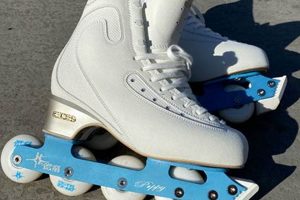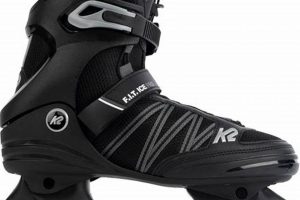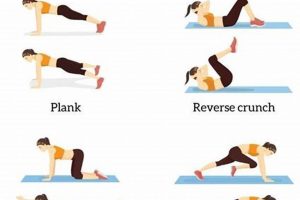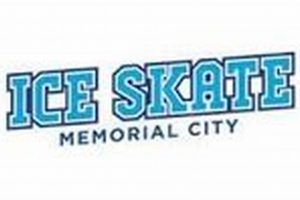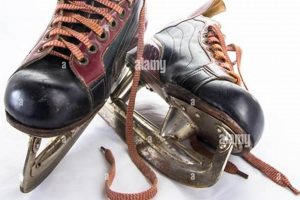The methods employed to halt movement on ice using bladed footwear involve manipulating edges and angles to create friction. Executing these techniques effectively requires practice and an understanding of balance, weight distribution, and edge control. Proficiency in these skills is crucial for safe navigation on ice surfaces.
Mastery of deceleration techniques is paramount for safety, injury prevention, and enhanced enjoyment of ice-based activities. Historically, rudimentary stopping methods evolved into refined techniques as the sport of ice skating developed. Competent execution allows for greater control and confidence, vital both in recreational skating and competitive disciplines.
Several fundamental approaches exist, each with varying degrees of complexity and suitability for different skill levels and situations. These techniques range from the simple snowplow stop, suitable for beginners, to more advanced methods requiring precise edge work and coordination. Understanding the nuances of each method is essential for developing a comprehensive skill set.
Techniques for Deceleration on Ice Skates
The following guidelines provide fundamental advice on methods for safely and effectively reducing speed and coming to a complete stop while wearing ice skates. Consistent practice is vital for developing proficiency.
Tip 1: Maintain a Balanced Stance. A slightly flexed knee position and a centered weight distribution over the skates will improve stability and control, enabling a more effective transfer of force during deceleration maneuvers.
Tip 2: Initiate the Snowplow Stop Gradually. When utilizing the snowplow, angling both skates inward simultaneously, pushing the heels outward while maintaining contact with the ice, allows for a controlled reduction in speed. Avoid abrupt, jerky movements.
Tip 3: Practice Edge Control. Experiment with shifting weight from one edge of the blade to the other. Understanding how the edges interact with the ice is fundamental to mastering advanced stopping techniques.
Tip 4: Progress to the Hockey Stop Deliberately. Transitioning to the hockey stop requires rotating the body and skates perpendicular to the direction of travel, applying pressure to the inside edge of one skate. Start at slow speeds and gradually increase as confidence grows.
Tip 5: Use Visual Cues. Before initiating a stop, identify a specific point to aim for. This helps maintain focus and ensures a controlled and predictable outcome.
Tip 6: Develop Ankle Strength. Strong ankles are essential for maintaining balance and controlling the skate blades. Incorporate exercises that strengthen the ankles and lower legs to improve overall skating performance.
Tip 7: Prioritize Safety Equipment. Helmets and other protective gear are crucial in mitigating the risk of injury, particularly when learning new and challenging stopping methods.
Consistent application of these principles will lead to increased confidence and improved ability in managing speed and safely halting momentum on the ice. Mastery of these deceleration techniques is essential for confident and controlled skating.
Further development of these skills will allow for exploration of more advanced skating maneuvers and techniques.
1. Balance
Balance constitutes a foundational element for any form of controlled movement, particularly when employing bladed footwear on ice. The ability to maintain equilibrium directly influences the effectiveness of deceleration techniques. An unstable posture inhibits precise edge control, diminishing the skater’s capacity to generate the necessary friction for stopping. A compromised center of gravity can lead to uncontrolled falls, negating the benefits of even the most well-executed stopping maneuver. For example, during a hockey stop, a skater lacking balance may rotate excessively or lose control of the trailing leg, resulting in a failed attempt.
Developing and maintaining balance in motion is crucial for executing stopping techniques safely and reliably. Drills focusing on single-leg stability, controlled gliding, and weight transfer are instrumental in improving balance. Furthermore, understanding the interplay between upper body positioning and lower body stability is key. For instance, using arm movements to counterbalance shifts in weight during a snowplow stop allows for greater control and stability. Practicing these techniques in a controlled environment, such as a designated skating lesson, allows skaters to build confidence and refine their balance skills before attempting more advanced maneuvers.
In summary, balance is an indispensable component of effective stopping techniques. Deficiencies in balance directly translate to reduced control and increased risk of injury. By prioritizing balance-focused training and diligently refining posture and weight distribution, skaters can significantly improve their ability to decelerate safely and confidently. Ignoring this critical connection undermines the effectiveness of all other stopping skills, potentially leading to hazardous situations on the ice.
2. Edge Control
Edge control serves as a cornerstone skill in deceleration techniques on ice. The ability to manipulate the angle and pressure applied to the skate blade’s edge directly dictates the effectiveness and control of a stop. Without proper edge control, halting momentum becomes unpredictable and potentially hazardous.
- Inside Edge Engagement
The engagement of the inside edge of the skate blade is fundamental to techniques like the hockey stop. Applying pressure to the inside edge while rotating the body allows the blade to dig into the ice, creating friction that reduces speed. Insufficient inside edge engagement results in a sliding, uncontrolled rotation, rather than a decisive stop.
- Outside Edge Resistance
While less directly involved in some stopping methods, outside edge control contributes to balance and stability during the deceleration process. Maintaining control of the outside edge of the non-braking skate provides a counterbalancing force, preventing over-rotation or loss of equilibrium. A failure to control the outside edge can lead to instability and a loss of control during the stopping maneuver.
- Edge Transitions
The smooth transition between edges is crucial for maintaining control and adjusting the stopping angle. Skaters must be able to seamlessly shift weight and pressure from one edge to another to modulate the amount of friction generated. Abrupt or jerky edge transitions can cause a loss of balance and a decrease in stopping efficiency. The snowplow stop, for instance, requires coordinated inward pressure on both inside edges.
- Edge Sharpening and Maintenance
The condition of the skate blade’s edges significantly impacts the skater’s ability to control them. Sharp, well-maintained edges provide superior grip on the ice, allowing for more precise and effective stopping. Dull or damaged edges reduce the blade’s ability to bite into the ice, leading to reduced control and increased stopping distance. Regular sharpening is essential for maintaining optimal edge control.
Effective manipulation of skate edges, through practiced technique and proper maintenance, directly correlates with the ability to stop reliably and safely. Mastering edge control provides the skater with the tools necessary to manage speed and direction, preventing collisions and promoting overall safety on the ice.
3. Weight Shifting
Weight shifting constitutes a critical mechanism in the process of deceleration on ice skates. The precise distribution of body mass directly influences the friction generated between the skate blade and the ice surface. A skater’s ability to effectively transfer weight dictates the success, efficiency, and safety of stopping maneuvers. For instance, in a hockey stop, shifting weight onto the inside edge of the braking skate facilitates a controlled slide perpendicular to the direction of travel. Failure to transfer weight adequately results in reduced friction, diminished stopping power, and an increased risk of losing control.
Practical applications of weight shifting extend beyond basic stopping techniques. Advanced maneuvers, such as controlled turns and transitions, heavily rely on the precise manipulation of weight distribution. For example, a controlled spin necessitates a concentrated weight shift towards the center of the spinning skate, ensuring stability and minimizing friction from the free leg. Similarly, during a cross-over turn, weight is strategically shifted from one skate to the other, enabling a smooth and efficient change in direction. Understanding the subtle nuances of weight shifting is crucial for mastering advanced skating skills and enhancing overall control on the ice. Correct weight placement can also assist in injury prevention, allowing for smoother landings and decreasing joint impact.
In summary, weight shifting is inextricably linked to the effective execution of stopping techniques on ice skates. Its influence pervades both basic and advanced maneuvers. Recognizing the critical role of weight distribution enables skaters to improve their control, safety, and overall performance. Mastering this element is paramount for achieving proficiency and navigating the ice surface with confidence. Difficulties in grasping these concepts often leads to falls and can undermine the learning curve to more complex movement.
4. Angle of Blade
The angle at which the skate blade contacts the ice surface exerts a significant influence on the ability to effectively decelerate and achieve a controlled stop. This parameter directly determines the amount of friction generated, impacting stopping distance and stability.
- Inside Edge Angle
The engagement of the inside edge, common in maneuvers such as the hockey stop, necessitates a pronounced angle relative to the ice. This angle allows the blade to dig into the surface, maximizing friction and rapidly reducing momentum. A shallow angle, conversely, reduces friction and increases stopping distance. Maintaining a consistent and controlled inside edge angle is vital for a predictable and reliable stop.
- Outside Edge Angle
While primarily utilized for balance and directional control, the outside edge angle indirectly affects stopping. During a snowplow stop, for instance, the outside edges of both skates may provide additional resistance as the blades are angled inward. A stable and controlled outside edge helps maintain overall balance and prevents unwanted slippage during deceleration.
- Blade Perpendicularity
Approaching a stop, the degree to which the blade is perpendicular to the direction of travel influences the efficiency of force transfer. In the hockey stop, the skate blade approaches a near-perpendicular orientation, allowing for a direct application of force against the direction of motion. Deviations from perpendicularity can reduce the effectiveness of the stop and increase the potential for instability.
- Angle Consistency
Maintaining a consistent angle throughout the stopping maneuver is crucial for a smooth and controlled deceleration. Fluctuations in the blade angle can lead to jerky movements and a loss of balance. Practicing controlled angle adjustments allows skaters to modulate the degree of friction and maintain a consistent stopping force. Experienced skaters develop a refined sense of angle consistency, allowing them to adapt to varying ice conditions and skating speeds.
In conclusion, the angle of the blade represents a critical variable in the mechanics of stopping with ice skates. Manipulating the angle of the blade relative to the ice dictates the frictional force generated, which in turn determines stopping distance and stability. Mastery of angle control enables skaters to execute controlled and predictable stops under diverse conditions.
5. Progressive Force
The application of progressive force is intrinsic to effectively decelerating while using ice skates. Abrupt application of force often leads to instability, loss of control, and potential injury. A gradual increase in the pressure applied to the blade edge allows for a controlled reduction in speed, maximizing friction without exceeding the skater’s capacity to maintain balance. For instance, when executing a snowplow stop, gradually increasing the inward pressure on the edges allows for a smooth deceleration, preventing a sudden stop that could cause a fall. Conversely, immediately forcing the skates into a wide snowplow angle at high speed can result in the skater losing their footing and skidding out of control.
The concept of progressive force extends beyond the initial contact with the ice. It encompasses the entire deceleration process, from the initiation of the stopping maneuver to the complete halt. In a hockey stop, the skater gradually increases the pressure on the inside edge as they rotate, allowing the blade to carve into the ice. This progressive application of force ensures that the skater maintains control throughout the stop, minimizing the risk of over-rotation or losing their edge. Moreover, the timing of force application is critical; applying maximum force too early can cause the skater to lock up and potentially lose control, while applying it too late may result in insufficient stopping power.
In summary, the successful execution of any deceleration technique on ice skates hinges on the principle of progressive force. This entails a gradual and controlled increase in pressure applied to the blade edge, allowing for a smooth and predictable reduction in speed. By prioritizing the progressive application of force, skaters can enhance their stability, control, and safety while navigating the ice. Neglecting this element can lead to unpredictable outcomes and increased risk of accidents. Skillful implementation of progressive force ultimately separates a competent skater from one who struggles with basic control.
Frequently Asked Questions About Deceleration Techniques on Ice Skates
This section addresses common inquiries regarding methods for safely and effectively stopping while wearing ice skates.
Question 1: What is the most basic method for stopping on ice skates suitable for beginners?
The snowplow stop is generally considered the most accessible technique for novice skaters. It involves angling both skates inward, creating a wedge shape with the toes pointed towards each other. Pressure is then applied to the inside edges of the blades, generating friction to slow down.
Question 2: What are the key differences between the snowplow stop and the hockey stop?
The snowplow stop employs both skates simultaneously in a symmetrical position. The hockey stop, conversely, involves rotating one skate perpendicular to the direction of travel and applying pressure to the inside edge. The hockey stop allows for quicker and more controlled stops but requires greater skill and coordination.
Question 3: How does ice condition affect the ability to stop effectively?
The condition of the ice surface directly impacts friction and, consequently, stopping effectiveness. Softer ice may offer more grip, while harder, smoother ice reduces friction, requiring greater force and precision to stop. Adjustments to technique may be necessary based on ice conditions.
Question 4: What role does blade sharpness play in successful deceleration?
Sharp skate blades are crucial for efficient stopping. Sharp edges provide enhanced grip on the ice, allowing for more precise control and reduced stopping distance. Dull blades diminish grip, requiring more force and increasing the risk of slippage and loss of control.
Question 5: How can balance be improved to enhance stopping ability?
Balance can be improved through focused practice on single-leg glides, weight transfer exercises, and core strengthening. Developing a stable and centered posture allows for more precise edge control and a greater ability to maintain balance during deceleration maneuvers.
Question 6: Is protective equipment necessary when learning to stop on ice skates?
Wearing protective equipment, including a helmet, knee pads, and elbow pads, is strongly recommended, especially when learning new or challenging stopping techniques. This equipment mitigates the risk of injury in the event of a fall.
Mastering methods of deceleration involves understanding the interplay between balance, edge control, blade angle, and force application. Consistent practice is essential for developing competence and confidence.
This concludes the discussion regarding frequently asked questions. The following section will address common errors.
Concluding Remarks on Safe Ice Skating
This exposition has detailed the critical elements of how to stop with ice skates. Balance, edge control, weight shifting, blade angle, and force application constitute the foundations of controlled deceleration. Mastery of these components ensures safe and predictable movement on ice.
Proficiency in stopping techniques is paramount for injury prevention and responsible participation in ice skating activities. Continued refinement of these skills will contribute to enhanced safety and enjoyment for all users of ice surfaces. Consistent attention to these principles is essential for mitigating risk and promoting a secure skating environment.


